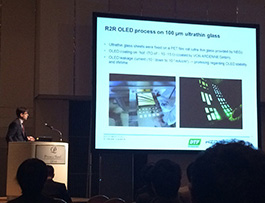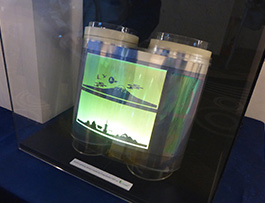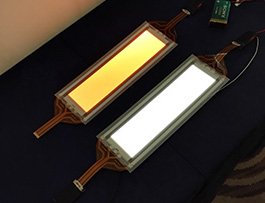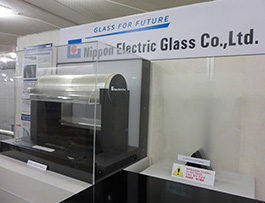Dec 28, 2015
Fraunhofer FEP, a research institution of the Fraunhofer – Gesellschaft, the largest applied research organization in Europe, is developing a roll to roll process for OLED lighting using flexible glass as substrate material. The scientists recently have shown the world first research sample of a flexible glass-glass OLED device made by this technology.
This OLED lighting device and G-Leaf™, NEG’s flexible glass used as a substrate and cover, were exhibited at NEG booth of IDW ’15 (International Display Workshops), which was held in Otsu Prince Hotel, from December 9th to 11th, 2015.
Dr. Stefan Mogck from Fraunhofer FEP also presented FEP’s highly conductive transparent electrodes and introduced the roll to-roll process development on flexible glass in his talk at the conference during IDW ’15.
Plastic films have been already used for OLED lighting and Organic PV applications in roll to roll process. However, there are still big challenges to guarantee barrier properties and durability to reach a reproducible certain product lifetime.
On the other hand, glass has perfect barrier properties and durability, which could extend the product lifetime. Successful modifications have been started on existing roll-to-roll equipment for handling and process of flexible glass to meet the challenging requirements for flexible OLED lighting.
In 2013, Fraunhofer FEP and NEG started an evaluation project for roll to roll processing for OLED lighting devices based on flexible glass. Last year, the first OLED lighting device with flexible glass substrate was made with PET cover, and this year, the world first OLED lighting device was made with flexible glass for both substrate and cover.
We hope that the process development using flexible glass for a longer product lifetime will advance soon for becoming a reliable starting point for further device developments.







